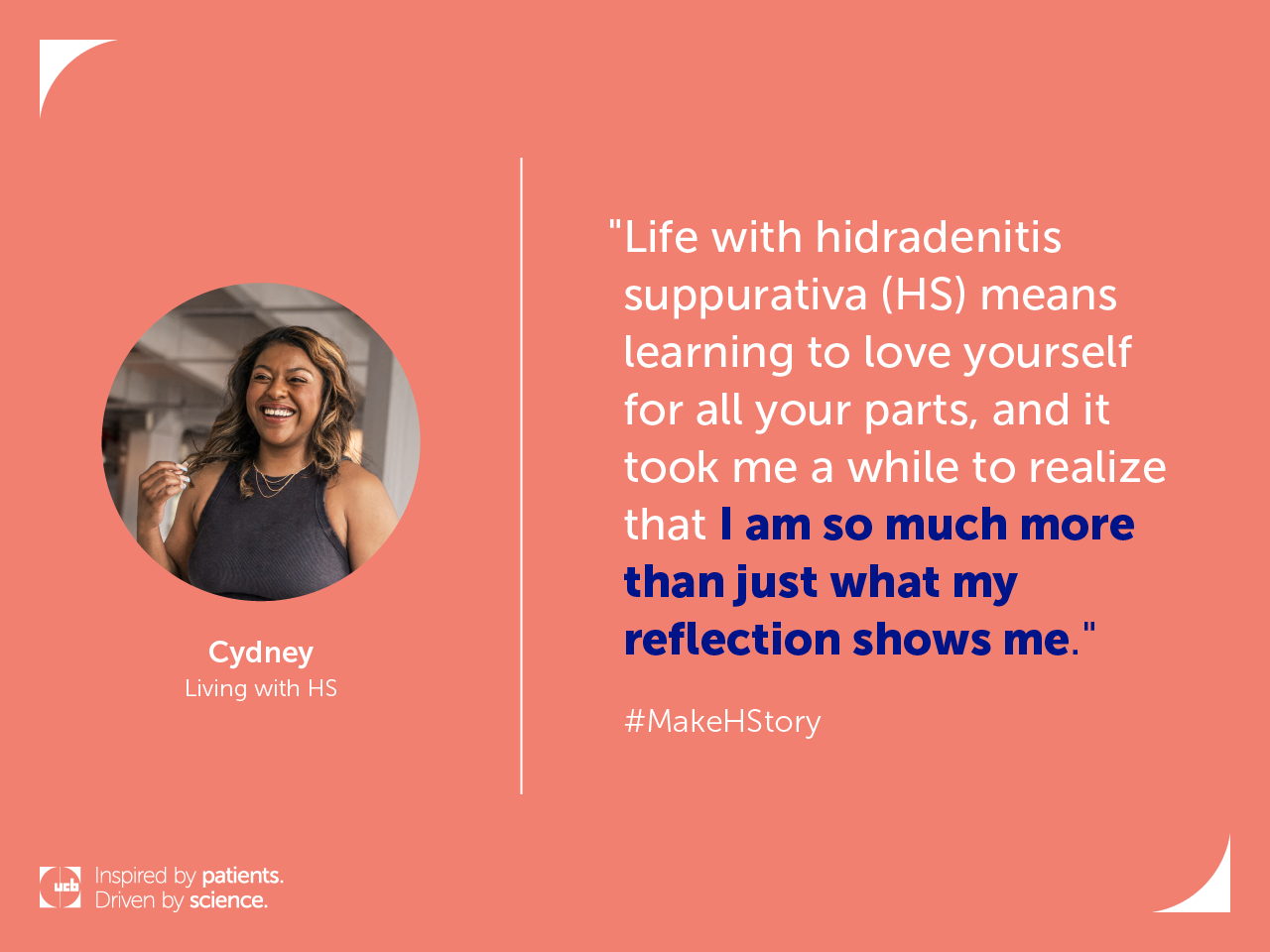
Cydney, who was diagnosed with hidradenitis suppurativa (HS) by her dermatologist as a teenager, knows too well how living with a severe, chronic disease can change your life. Many people with HS face a long and complex path to diagnosis that often takes a high physical toll, in addition to psychological and emotional tolls.
HS is a chronic, recurring, painful, and debilitating inflammatory skin disease.1 Symptoms include nodules, abscesses, and tunneling – painful tracks beneath the skin – primarily affecting areas like, but not limited to, the armpits, groin, and buttocks.1,2,3 In addition to the physical symptoms, those diagnosed with the disease often express feelings of isolation, embarrassment, and low self-esteem.4,5 HS is typically clinically unrecognized or ill-defined with the average time from symptom onset to an accurate diagnosis at around 10 years.6 Such a delay in diagnosis allows for disease progression to more severe stages, particularly in cases of aggressive progression.6
Understanding Needs and Bridging the Gaps with Dermatologists
UCB is proud to unveil our disease-state education campaign – Make HStory – designed to empower the estimated 0.1% of people in the U.S. impacted by this serious disease to engage in meaningful discussions with their dermatologist.1 Launched as a partner to the Make HStory medical education campaign, the patient campaign represents a significant milestone for UCB and reinforces our ongoing commitment to those living with HS.
Created in partnership with individuals living with HS, like Cydney, as well as dermatologists and other HCPs, Make HStory showcases individual stories of those living with this severe disease, details the everyday struggles and triumphs they face, and offers educational resources and daily care tips specific to people living with HS.
The comprehensive Make HStory websites feature a broad range of materials, including:
- For people living with HS and their providers:
- Stories of people living with HS
- Tools to help strengthen both patient and dermatologist understanding of the disease, how it presents in the body, and the experiences of dermatologists who regularly treat people living with HS
- Resources specific to people living with HS:
- Resources to help mobilize diagnosed individuals to have a conversation with their dermatologist about management options
- Tips on managing flares
- A printable list of questions to ask their dermatologists
- A dermatologist locator
- Provider-specific resources:
- A suite of materials of downloadable in-office tools, such as documents outlining the North American and European Standards of Care, to help their ongoing care of people living with HS
“Life with HS means learning to love yourself for all your parts, and it took me a while to realize that I am so much more than just what my reflection shows me. I’m so happy my story is featured in this campaign, knowing that this website will help people in the community feel heard and not alone, and it will give them access to the tools and information they may need to manage their life with HS,” said Cydney.
At UCB, we keep patients at the heart of everything we do, providing solutions that go beyond just medicines. We hope Make HStory and its new resources can provide the dermatology community with better tools to personalize care and help HS patients live their best possible life. To learn more about UCB’s commitment to people living with severe immune-mediated diseases, visit ucb-usa.com, and to stay up to date on the latest HS resources, follow us on Instagram at @makehstory and on Facebook at www.facebook.com/makehstory.
References
- Lee EY, et al. What is hidradenitis suppurativa? Can Fam Physician. 2017 Feb;63(2):114-120.
- Ingram JR. The epidemiology of hidradenitis suppurativa. Br J Dermatol. 2020 Dec;183(6):990-998. doi: 10.1111/bjd.19435. Epub 2020 Sep 3. PMID: 32880911.
- Garg A, et al. Real-world findings on the characteristics and treatment exposures of patients with hidradenitis suppurativa from US claims data. Dermatol Ther (Heidelb). 2023 Feb;13(2):581-594. doi: 10.1007/s13555-022-00872-1. Epub ahead of print. PMID: 36585607.
- Shukla N, et al. Identifying barriers to care and research in hidradenitis suppurativa: findings from a patient engagement event. Br J Dermatol. 2020;182(6):1490-1492. doi:10.1111/bjd.18818
- Mahon JM, et al. An update on health-related quality of life and patient-reported outcomes in hidradenitis suppurativa. 2020;11:21-26. https://www.ncbi.nlm.nih.gov/pmc/articles/PMC7021915/. Accessed March 2024.
- Kokolakis G, et al. Delayed diagnosis of hidradenitis suppurativa and its effect on patients and healthcare system. Dermatology. 2020;236(5):421-430.
©2024 UCB, Inc., Smyrna, GA 30080. All rights reserved.
US-DA-2400129
Choose Country
- Global Site – English
- Australia – English
- België – Engels
- Belgique – Anglais
- Brasil – Português
- България – Български
- Canada – English
- Canada – Français
- 中国 – 中文
- Česká Republika – Angličtina
- Danmark – Engelsk
- Deutschland – Deutsch
- France – Français
- España – Español
- Ελλάδα – Ελληνικά
- India – English
- Ireland – English
- Italia – Inglese
- 日本 – 日本語
- Казахстан – ағылшын тілі
- 한국 – 한국어
- Luxembourg – Anglais
- Luxemburg – Engels
- Magyarország – Angol
- México & Latinoamérica – Español
- Nederland – Engels
- New Zeeland – English
- Norge – Engelsk
- Österreich – Deutsch
- Polska – Polski
- Portugal – Inglês
- România – Engleză
- Россия – Русский
- Slovensko – Anglický
- Suomi – Englanti
- Sverige – Engelska
- Schweiz – Deutsch
- Suisse – Français
- Türkiye – Türkçe
- Україна – Англійська
- United Kingdom – English
- U.S.A. – English



